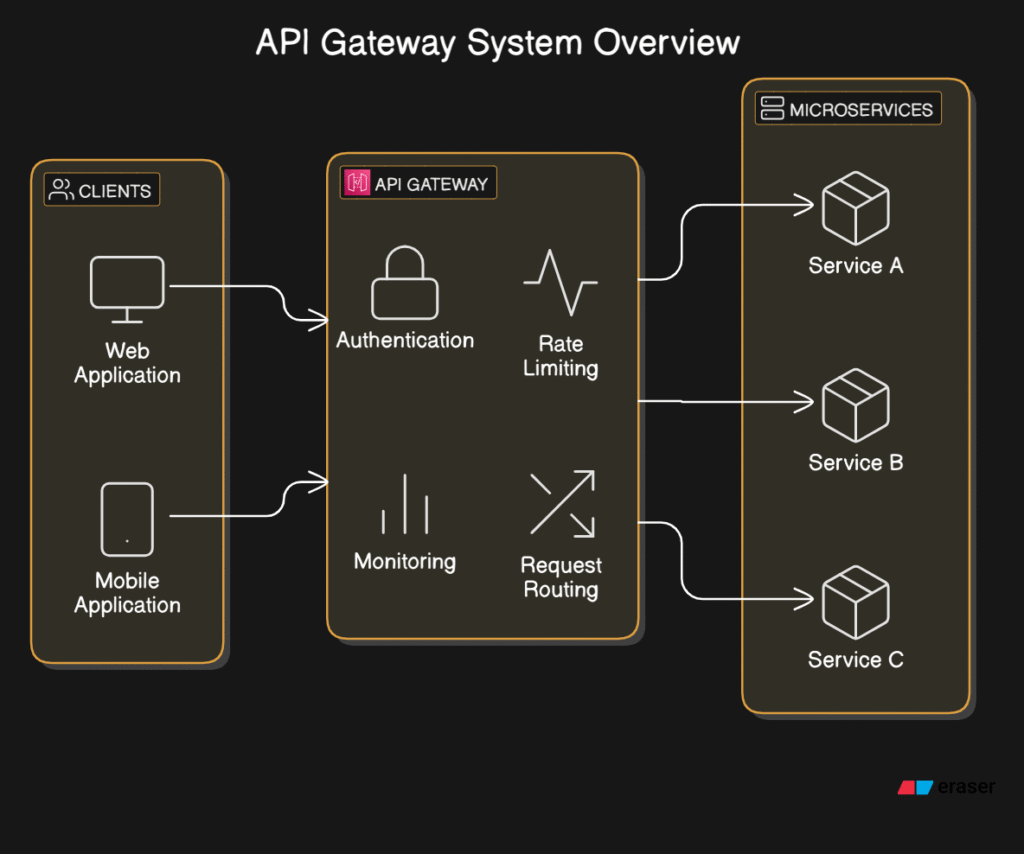📌 Introduction
An API Gateway is a crucial component in scalable systems, enabling secure and efficient communication between clients and microservices. It helps ensure seamless request routing, load distribution, and centralized authentication. This guide will cover everything you need to know about API Gateways, from its basics to real-world use cases.
⚙️ What is API Gateway?
An API Gateway is a server that acts as a single entry point for a set of microservices. It is used to manage, authenticate, route, and monitor API traffic between clients and services. Essentially, it abstracts the internal architecture and provides a unified interface for clients.
🧩 Key Benefits
- Scalability: Handles high-volume requests by distributing traffic and providing caching mechanisms.
- Reliability: Enables circuit breakers, retries, and rate limiting to make systems fault-tolerant.
- Efficiency: Combines multiple service requests into one (aggregation), reducing client-server round trips.
- Security: Centralized authentication, authorization, and SSL termination.
🔧 Types of API Gateway
- Edge Gateway: Placed at the edge of the system, handling all incoming requests.
- Internal Gateway: Used within internal networks to manage service-to-service communication.
- Hybrid API Gateway: Supports both external and internal communication with advanced configurations.
📊 Architecture

– API Gateway: Acts as the unified entry point for all external API requests.
– Microservices: Individual services that are accessed via routes configured in the gateway.
🔁 Use Cases
- Real-Time Systems: Manages API traffic for live applications like messaging or gaming apps.
- Microservices: Enables independent scaling, versioning, and secure access to services.
- Edge Cases: Helps implement rate limiting, IP whitelisting, and API metering.
⚙️ Tools & Services
- Open-Source Tools:
- Kong: A scalable, open-source API Gateway with plugins for security and traffic control.
- KrakenD: High-performance open-source gateway focused on aggregation.
- Cloud-Native Solutions:
- Amazon API Gateway: Fully managed API Gateway that supports RESTful and WebSocket APIs.
- Azure API Management: Offers full lifecycle management for APIs with built-in analytics.
✅ Best Practices
- Use Rate Limiting: Protects services from abuse and ensures fair usage.
- Secure All Endpoints: Implement centralized authentication and SSL/TLS encryption.
- Monitor and Log: Use logging and monitoring tools to detect bottlenecks and failures.
🔐 Security Implications
- DDoS Attacks: The gateway is exposed; enable rate limiting and IP filtering to mitigate.
- Authentication Flaws: Use OAuth 2.0, JWT, and API keys to secure access.
📚 Real-World Examples
- Netflix: Uses Zuul (and later Spring Cloud Gateway) for request routing and filtering.
- Amazon: Leverages AWS API Gateway to serve APIs for various microservices.
- Airbnb: Manages internal and external APIs using a custom-built API gateway infrastructure.
🚀 Conclusion
The API Gateway plays a pivotal role in modern, scalable system design. It simplifies communication, enhances security, and improves client-side efficiency by abstracting complex internal systems. Understanding and correctly implementing an API Gateway is critical for maintaining performance, flexibility, and security in microservice-based architectures.
3 FAQs About API Gateway
- What is the primary function of an API Gateway?
An API Gateway acts as a reverse proxy that routes requests from clients to the appropriate microservices, often adding features like authentication, logging, and caching. - How does an API Gateway improve system performance?
It reduces latency by aggregating multiple calls, manages load, and handles caching and rate limiting to optimize performance. - What are some common pitfalls when using an API Gateway?
Overloading the gateway with logic, lack of proper security configuration, and single point of failure are common issues that should be addressed with care.

